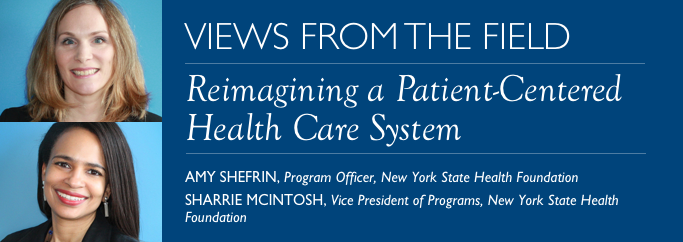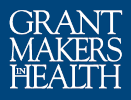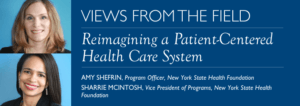
The term “patient-centered” has been around for a long time. The Institute of Medicine brought it to prominence with its 2001 seminal report “Crossing the Quality Chasm: A New Health System for the 21st Century,” and the term was interwoven into goals embodied in the Affordable Care Act. Most recently, the term has gained increasing use—sprinkled across the confirmation hearings of the new Secretary of the Department of Health and Human Services, and used in talking points for the American Health Care Act proposal.
At the New York State Health Foundation (NYSHealth), where we launched a new priority area, Empowering Health Care Consumers, in 2016, it is gratifying to see that our nascent program is “on trend,” with both sides of the aisle extolling the virtues of a patient-centered health care system. But we have observed patient-centered become a Rorschach test, claimed equally by people with differing views as to what the term means.
Increasingly, the term patient-centered has been used as rationale for policies that entail high-deductible health plans, higher cost sharing, and shifting of accountability from the health care industry. If this is a Rorschach test, we see something different. Our vision for Empowering Health Care Consumers, for making the system more patient-centered, means shedding burdens on consumers.
One of the best conceptualizations of a patient-centered vision comes from Amy Berman of the John A. Hartford Foundation. In a speech, she remarks, “we live in a pre-Copernican model where all the planets float around the health care system; the patient is just one of them.” Her conclusion? “We need the person at the center.” In other words: patients are the sun.
NYSHealth’s approach for putting patients at the center is to support efforts–at the individual, system, or policy level—that empower patients to be drivers of and partners in their own health and health care. We have shaped our Empowering Health Care Consumers program around two themes: choice and control. Assessing if a potential project improves an individual’s choices or control has become our litmus tests for identifying if a project truly empowers consumers.
We see the opportunity for greater choice and control through information and instruments. Information, for example, about health care prices and quality can inform choices and promote competition that benefits consumers. We also recognize that consumer empowerment is not just about addressing an information gap. In 2015, a national report by Consumer Reports found that 87% of respondents did not know which state agency or department is charged with helping consumers with health insurance problems. In addition to information, we must support the development of instruments that help consumers navigate the health care system, as well as effective channels for self-advocacy and redress, which can help patients have a stake in their health care experience.
As we have been developing this new priority area, we have framed our grantmaking to both arm people with information and resources, and to encourage providers, insurers, government, and policymakers to play an enhanced role in empowering patients and consumers. Everyone that encounters the patient or has the potential to influence the health care experience for that patient can have the same shared mandate: to support individuals’ choice and control.
We can start by examining the expectations set for consumers. When our foundation issued a call for proposals for empowering health care consumers, a number of pitches were for projects focused on health literacy. Although our foundation acknowledges health literacy as a problem, we also recognize that the health care system is challenging to navigate; that decisions that drive access, affordability, and agency are often beyond an individual’s control; and that individuals can face systemic, recurring hurdles. Our belief is that health literacy is not a problem to be solved only by patients; rather it is a shared responsibility. Health providers, the government, and other stakeholders should also play a role in making the system more accessible and responsive to patients.
As a foundation, it has become important for us to frame our grantmaking to be responsive to what matters most to patients, while encouraging insurers, providers, and policymakers to adopt a similar lens. While patient-centered care requires shedding consumer burden, it is not yet clear if all stakeholders are ready to shoulder this burden. For example, consumers’ biggest concerns tend to be cost and affordability. Yet are hospitals and insurers making it easier for consumers to compare prices?
Quality and Price Information
Our grantmaking has sought to encourage information transparency and spur changes in the quality and price information that the State, insurers, and hospitals make public. We are supporting projects that will ensure more transparency tools for consumer use. For example, we are funding IMPAQ to produce a consumer tool that compares New York health plans’ estimated out-of-pocket costs for patients with high-cost conditions. We commissioned the APCD Council to produce a report to build consensus for a robust all-payer database in New York to offer consumers meaningful price and quality information. A grant to Cynosure will apply a new lens to network adequacy by rethinking how consumers might compare health plans by the performance and quality of the providers in their networks. True choice requires information.
Personal Health Care Information
Another challenge we have heard from consumers is the difficulty they face when trying to access or share their personal health care information. We are certainly not putting patients at the center if we treat their medical records as the property of the provider. NYSHealth is supporting projects related to expanding OpenNotes statewide, ensuring that HIPAA is not misused to bar legitimate access to health information, and fostering best practices to make such information access accessible and routine.
Patient Voice
A constant refrain from consumers is that their voices are not being heard. Rather than being considered partners in their own health, they are treated as bystanders whose advice and perspective is solicited as an afterthought. To address this, we are supporting a scan of Patient and Family Advisory Councils, a mechanism used to incorporate patient voices, to assess their prevalence in New York State, as well as the extent to which they are used to meaningfully engage patients. In a project with Mergerwatch, we are also supporting an effort to bring consumer voices to the table in the state process that approves hospital consolidations.
Consumer Protections
Empowering people also means publicizing consumer protections. We do not believe that educating consumers one by one will change the power imbalance that exists. That is why we are supporting an initiative to identify the range of consumer assistance resources in New York State, as well as areas for improvement. There is great appeal in philanthropy to generate new models and novel approaches—but in many cases these consumer protections already exist, while awareness of them is low. We can make great strides simply by connecting people to the resources that exist, and making these resources better.
Developing and launching this new program has been exciting, challenging, and illuminating for our foundation, and we hope to enlist other funders in this endeavor. It is a timely moment to ask ourselves how the field of philanthropy could better serve patients and consumers. Focusing on these issues will require us to be bold, because empowering consumers often means ruffling the feathers of entrenched interests. Supporting an empowered consumer can require a shift in the power dynamics between patient and provider, a health care team that views the patient as an expert on equal footing, new consumer protections such as surprise bill laws, price and quality transparency, and information sharing—concepts that are not always welcomed by various stakeholders. But if the result of our efforts is a system better designed to serve the public’s interest, they will have been worth it.
Of course, before Copernicus, it was mistakenly thought that the Earth was the center of the universe— and it took over 150 years for his theory to start gaining favor. The acceptance of his discovery gave rise to modern astronomy and the scientific revolution. As funders, we can adopt a shared understanding of what it means to be patient-centered, with—as Amy Berman put it—the patient as the sun. Just imagine what this collective shift in perception could give rise to in health and health care.

